Arthroscopic sports
Arthroscopic sports surgery, also known as arthroscopy or keyhole surgery, is a minimally invasive surgical procedure used to diagnose and treat various sports and no sport -related orthopedic injuries and disorders. It involves using an arthroscope, a thin,rigid fiber-optic telescope with a camera attached on one end, to visualize the interior of a joint through a small incision. The images captured by the camera are displayed on a monitor, allowing the surgeon to examine the joint's structures in real-time.One or more accessory channels are created during arthroscopy to perform diagnostic or therapeutic procedures.Arthroscopic surgery has fast recovery and extremely low wound complication rates.

Arthroscopic sports surgery is commonly performed on joints such as the knee, shoulder, hip, ankle, elbow and wrist to address a range of sports-related injuries, including:
1. Meniscus Tears:
Arthroscopy can be used to repair or trim torn meniscus cartilage in the knee.
2. Anterior Cruciate Ligament (ACL) Tears:
Arthroscopic ACL reconstruction is a common procedure to recontruct a torn ACL in the knee using tissue grafts.
3. Rotator Cuff Tears:
Arthroscopic surgery is often used to repair tears in the rotator cuff tendons of the shoulder.
4. Labral Tears:
Labral tears in the shoulder or hip can be treated with arthroscopic surgery.
5. Cartilage Injuries:
Arthroscopy can be used to evaluate and treat various cartilage injuries in the joints.
6. Loose Body Removal:
Small bone or cartilage fragments can be removed using arthroscopy.
Benefits of arthroscopic sports surgery include:
- Minimally Invasive: The procedure requires only small incisions, leading to less tissue damage, reduced scarring, and faster recovery compared to traditional open surgery.
- Accurate Diagnosis: The arthroscope provides high-resolution images of the joint's interior, allowing for precise diagnosis of the injury.
- Targeted Treatment: The surgeon can directly access the affected area and perform repairs or reconstructive procedures with specialized instruments.
- Shorter Recovery Time: Due to the minimally invasive nature of arthroscopy, patients often experience less post-operative pain and can return to sports and activities more quickly.
- Outpatient Procedure: In many cases, arthroscopic sports surgery can be performed on an outpatient basis, allowing patients to return home the same day.
However, not all sports-related injuries can be treated arthroscopically. The suitability of arthroscopic surgery for a specific injury depends on factors such as the type and severity of the injury, the patient's overall health, and the surgeon's expertise.
If you have a sports-related injury or are experiencing joint pain or instability, consultation with an orthopedic surgeon or sports medicine specialist will determine if arthroscopic sports surgery is a suitable option for your condition.
